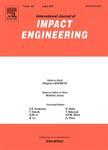版权所有:内蒙古大学图书馆 技术提供:维普资讯• 智图
内蒙古自治区呼和浩特市赛罕区大学西街235号 邮编: 010021

作者机构:Natl Univ Singapore Dept Mech Engn Impact Mech Lab 9 Engn Dr 1 Singapore 117575 Singapore Nanjing Univ Sci & Technol Sch Mech Engn Nanjing Jiangsu Peoples R China
出 版 物:《INTERNATIONAL JOURNAL OF IMPACT ENGINEERING》 (国际冲击工程杂志)
年 卷 期:2019年第127卷
页 面:1-16页
核心收录:
学科分类:12[管理学] 1201[管理学-管理科学与工程(可授管理学、工学学位)] 08[工学] 0802[工学-机械工程] 0801[工学-力学(可授工学、理学学位)]
主 题:Fabric-metal assemblies Arrangement sequence Projectile impact Ballistic limit Impact energy absorption capacity
摘 要:Fabrics woven from high-strength fibres are increasingly employed for protection against projectile impact, because of superior mechanical properties. In some applications, high-strength fabrics are combined with metallic components to provide sufficient structural rigidity and strength - e.g. for vehicle bodies, turbine engine fragment barriers, building doors, etc. An understanding of how the fabric-metal layer sequence affects the resulting ballistic resistance, is essential for effective design of such fabric-metal assemblies. This motivates the current study, whereby multiple plies (1, 2 or 4) of Twaron (T) aramid fabric were combined with an aluminium alloy (A) thin plate to form a lightweight protective panel. The projectile impact penetration resistance of three types of fabric-metal arrangements were examined - i) the aluminium alloy plate as the impact face;ii) the Twaron fabric as the impacted layer;iii) the aluminium alloy plate sandwiched between fabric layers. For assemblies with a smaller number of fabric plies (i.e. 1 or 2), siting the aluminium alloy plate as the rearmost layer results in a significantly higher impact energy absorption capacity, compared to having the aluminium alloy plate as the impact face - e.g. for (A +1T) assemblies, i.e. A1 plate + 1 ply of Twaron, IT/A (impact face layer appears first in this nomenclature) performs much better than A/1T. For (A + 2T) assemblies, 2T/A provides the highest impact resistance, A/2T is the weakest, and 1T/A/IT lies in between. However, when the number of fabric plies is increased to 4, a variety of responses was observed. An A/4T configuration absorbs significantly higher energy than a 4T/A arrangement, while a symmetrical 2T/A/2T sequence absorbs less energy than either an A/4T or 4T/A configuration. High-speed optical photography images and post-test specimens were analysed, to examine the deformation and failure modes of the fabric plies and A1 plate in the fabric-metal targets, and how they ar